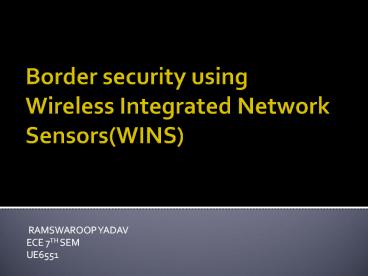Border security using Wireless Integrated Network Sensors(WINS) - PowerPoint PPT Presentation
Title:
Border security using Wireless Integrated Network Sensors(WINS)
Description:
WINS require a microwatt of power so it is very cheaper than other security system such as ... LWIM (Low power wireless ... Densely distributed sensor networks. – PowerPoint PPT presentation
Number of Views:5418
Avg rating:3.0/5.0
Title: Border security using Wireless Integrated Network Sensors(WINS)
1
Border security usingWireless Integrated Network
Sensors(WINS)
- RAMSWAROOP YADAV
- ECE 7TH SEM
- UE6551
2
Overview
- INTRODUCTION
- RECENT DEVELOPMENT
- WINS System Architecture
- WINS Node Architecture
- WINS Micro sensor
- WINS Digital Signal Processing
- WINS characteristics application
- Design consideration
- Conclusion
3
INTRODUCTION
- Wireless Integrated Network Sensors (WINS) now
provide a new monitoring and control capability
for monitoring the borders of the country. - Using this concept we can easily identify a
stranger or some terrorists entering the border. - The border area is divided into number of nodes.
Each - node is in contact with each other and with
the main node. - The noise produced by the foot-steps of the
stranger are collected using the sensor. This
sensed signal is then converted into power
spectral density and the compared - with reference value of our convenience.
4
INTRODUCTION (WINS)
- WIRE LESS INTEGRATED NETWORK SENSOR(WINS)
- WINS provide a new monitoring and control
capability for monitoring the Border of the
country. - WINS require a microwatt of power so it is very
cheaper than other security system such as Radar
and produce less amount of delay. - It produce a less amount delay to detect the
target. - It is reasonably faster.
- On global scale wins will permit monitoring of
land ,water and air resources for environment
monitoring.
5
DEVELOPMENT OF WINS
- WINS Initiated in 1993 under Defence advance
research project agency(DARPA)in US. - LWIM (Low power wireless integrated
microsensor)program began in 1995 for further
development os WINS sponsored by DARPA. - In 1998, WINS NG introduced for wide varity of
application. - the LWIM project ? multihop, self-assembled,
wireless network algorithms for operating at
micropower levels.
6
worldwide user
local area
low power networking
Internet
sensing
wireless communication
signal processing / event recognition
7
Distributed sensor at Border
8
WINS System Architecture
- WINS architecture includes sensor, data
converter, signal processing, and control
functions. - The micro power components operate continuously
for event recognition, while the network
interface operates at low duty cycle.
Continuous operation low duty
cycle
9
WINS NODE ARCHITECTURE
- 1998 WINS NG developed by the authors ?
contiguous sensing, signal processing for event
detection, local control of actuators, event
classification, communication at low power - Event detection is contiguous ? micropower levels
- Event detected gt alert process to identify the
event - Further processing? Alert remote user /
neighboring node? - Communication between WINS nodes
10
WINS NODE ARCHITECTURE(cont..)
- WINS nodes are distributed at high density in an
environment to be monitored. - WINS node data is transferred over the asymmetric
wireless link to an end user
11
Nodes connection of WINS
12
WINS MICRO SENSORS
- The detector shown is the thermal detector. It
just captures the harmonic signals produced by
the footsteps of the stranger entering the
border. - These signals are then converted into their PSD
values and are then compared with the reference
values set by the user.
Thermal Infrared Detector
13
REMBASS
- Remotely monitored battlefield sensor
system(REMBASS) - Use now a day in unattended ground sensor(UGS)
- These sensor used seismic-acoustic energy,
infrared energy and magnetic field to detect
enemy activity.
14
Sensor board
Fig. . Sensor hardware from left to right (a)
Mica2 network node, (b) Mica Sensor Board, (c)
Mica Power Board, (d) TWR-ISM-002 Radar Board,
and (e) All of the boards attached together.
15
WINS DIGITAL SIGNAL PROCESSING
- If a stranger enters the border, his foot-steps
will generate harmonic signals. It can be
detected as a characteristic feature in a signal
power spectrum. Thus, a spectrum analyzer must be
implemented in the WINS. - The spectrum analyzer resolves the WINS input
data into a low-resolution power spectrum.
WINS micropower spectrum analyzer architecture
16
WINS characteristics application
- Characteristics
- Support large numbers of sensor.
- Dense sensor distributions .
- These sensor are also developed to support short
distance RF communication - Internet access to sensors, controls and
processor
17
Application
- On a global scale, WINS will permit monitoring of
land, water, and air resources for environmental
monitoring . - On a national scale, transportation systems, and
borders will be monitored for efficiency, safety,
and security. - On a local, enterprise scale, WINS will create a
manufacturing information service for cost and
quality control.
18
Design consideration
- Reliability
- Energy There are four way in which node consume
energy - Sensing
- Computation
- Storing
- Communicating
- Sensing Choosing right sensor for the job can
improve the system performance.
19
Packaging
- The sensor must be design to minimize the
liklihood of environment effect of wind,
rain,snow etc. - The enclosure is manufacture from clear acrylic
material.
Enclosure
20
Unanticipated faulty behavior
- We experienced several failure as a result of
undetectable, incorrectly download program and
depeleted energy level etc. - For example node will detect false event when
sensor board is overheated.
21
Conclusion
- Densely distributed sensor networks.
- Application specific networking architectures
- Development platforms are now available .
- The network is self-monitoring and secure.
- . Now it is possible to secure the border with an
invisible wall of thousands or
even millions of tiny interconnected sensors.
22
THANK YOU





























